After spending time in the jazz capital of the world (New York City), it’s time to explore some other jazz clubs. But before we leave the East Coast, there’s another spot that is worth checking out. We’re headed to Massachusetts. The city? Boston. The club? Storyville. It’s another exploration in ‘Nightclub Jazz’, the sub-genre of jazz I’m using to explore and rediscover my record collection.The Music
The Tune: “Give A Little Whistle/ Oh Lady Be Good”
Recorded: 2 October, 1952 at Storyville, Boston MA
Personnel:
- Paul Desmond- Alto Sax
- Dave Brubeck- Piano
- Lloyd Drums- Drums
The Tune: “Tea For Two”
Recorded: February 1953 at Storyville, Boston, MA
Personnel:
- Paul Desmond- Alto Sax
- Dave Brubeck- Piano
- Ron Crotty- Bass
- Lloyd Davis- Drums
The Tune: “This Can’t Be Love”
Recorded: 1952 at the Surf Club, Hollywood, CA
Personnel:
- Paul Desmond- Alto Sax
- Dave Brubeck- Piano
- Wyatt Ruther- Bass
- Herb Barman- Drums
Yes, I already wrote about this album in a previous post, but that was more of a tribute to Dave Brubeck. This post highlights the album on its own merits, with the added attraction of better vinyl rips due to improved equipment. So let’s step inside the club!
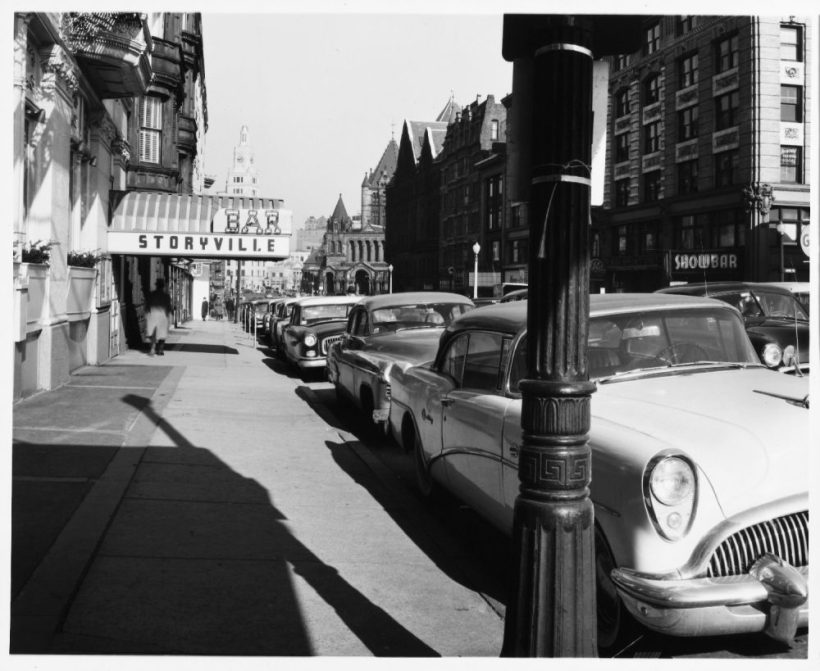 The jazz club known as Storyville was opened by George Wein in 1950 in Boston, Massachusetts. It was named after the red-light district of New Orleans, Louisiana known as ‘Storyville’, where jazz was said to have originated. George Wein was a jazz promoter and musician himself (he started the Newport Jazz Festival a few years later in 1954), and many jazz greats played and recorded there. Charlie Parker, Lee Konitz, Gerry Mulligan, Stan Getz, Billie Holiday, Ella Fitzgerald, Erroll Garner… you get the idea. It was a jumping place in it’s heyday. One group that frequently played there was the Dave Brubeck Quartet. Radio broadcasts and recordings capture them there from 1952-1954. Remarkably, despite having two and a half (two 12-inch LPs and one 10-inch LP) albums of Storyville material released, they were never professionally recorded there by a record company. All their albums from this club were sourced from radio broadcasts or personal tape recorders from club patrons. Enter this album.
The jazz club known as Storyville was opened by George Wein in 1950 in Boston, Massachusetts. It was named after the red-light district of New Orleans, Louisiana known as ‘Storyville’, where jazz was said to have originated. George Wein was a jazz promoter and musician himself (he started the Newport Jazz Festival a few years later in 1954), and many jazz greats played and recorded there. Charlie Parker, Lee Konitz, Gerry Mulligan, Stan Getz, Billie Holiday, Ella Fitzgerald, Erroll Garner… you get the idea. It was a jumping place in it’s heyday. One group that frequently played there was the Dave Brubeck Quartet. Radio broadcasts and recordings capture them there from 1952-1954. Remarkably, despite having two and a half (two 12-inch LPs and one 10-inch LP) albums of Storyville material released, they were never professionally recorded there by a record company. All their albums from this club were sourced from radio broadcasts or personal tape recorders from club patrons. Enter this album.
This album was released twice by Fantasy; once as a 10-inch album that contained four tracks documenting two different gigs at Storyville, and a second time as a 12-inch album with the same material as the 10-inch, but with two added tracks from two seperate locations and personnel. Fantasy Records was crazy like that. My album is the 12-inch record. I included three vinyl rips because each track comes from a different set and thus has a different flavor.
The first three tracks stem from an October 1952 appearance at Storyville and features the odd instrumentation of sax, piano, drums, and no bass. According to Brubeck, the bassist was sick. According to Nat Hentoff, the bassist simply couldn’t make it. According to Desmond, the bassist was upstairs in his hotel room, asleep in the bathtub. We’ll never know, but he probably couldn’t make it on account of being sick, and was in the bathtub to help with his fever. At any rate, his absence, coupled with the quiet brushing of the drummer (who was also sick, as it turns out) made these first recordings sound like a duet between Desmond and Brubeck. Desmond and Brubeck’s empathy and ESP is on full display on these recordings. Desmond’s solo on “You Go To My Head” is one his best and a moving piece of music. It’s also full of quotes of other tunes. These recordings were Desmond’s favorite, as they captured that spontaneous, experimental mood jazz musicians infrequently experience on the bandstand afterhours. Another reason why nightclub recordings of jazz are some of the best jazz available.
The first two tracks that make up side one are reflective ballads, so it’s only natural that side two opens up with more upbeat music. The opener is from the same October ’52 set as the previous tunes, but is in a different mood. Brubeck opens with some jaunty chords, then Desmond sails in with the melody to “Give A Little Whistle”, from the Disney movie ‘Pinocchio’. Everything is fine and dandy till the bridge, when it becomes evident that this isn’t “Give A Little Whistle” at all- it’s Gershwin’s “Oh, Lady Be Good”. What gives? It’s a case of Desmond throwing the melody of “Whistle” onto the harmonies of “Lady Be Good” (I have my suspicions as to why, but I’ll save that for a different post). Desmond’s solo is imaginative, but Brubeck’s solo is more orchestral and exploratory, briefly moving into a minor key before quickly returning to the major. His piano solo gets Desmond’s audible approval in the form of two “yeah”s. The real fun is when Desmond returns and the two engage in two choruses of improvised counterpoint that would have impressed Bach. These three recordings were recorded by a night club patron who luckily had a personal tape recorder.
“Tea For Two” comes from an appearance at Storyville in February of 1953, and this time the whole quartet is present and accounted for. The arrangement is exactly like the one Brubeck recorded with his trio in the late 1940’s with his trio, the only difference being Desmond’s alto. Desmond’s solo here is a great example of his technique where he sounded like he was playing a duet with himself. He plays a phrase in the upper register of the horn, then immediately answers it in the lower register. It’s a fun bit of Desmondology that he pulls off effectively here. This recording, better in audio quality, comes from a radio broadcast.
The two tracks pegged on to form the 12-inch record are culled from two completely different live appearances. “Crazy Chris” is from a 26 June, 1955 concert in Carmel, California. “This Can’t Be Love” is from a 1952 aircheck of a radio broadcast out of the Surf Club in Hollywood, California. I chose to highlight “This Can’t Be Love” because it’s from a jazz club and because of Brubeck’s wild solo. Brubeck was labeled ‘bombastic’ due to his tendency to go thundering away on the piano. Critics and detractors used this label like a curse word, but Brubeck wore bombastic well. This solo is a great example of that. After Desmond’s lithe solo, Brubeck starts off equally restrained and fluid but quickly moves to using dense, rich chords. He further develops his solo with even denser chords, and before long, he’s rearranging the piano keys. After his rhythmic workout, he pulls back and lets the bass have some time to shine. Of course, I’m biased, but it’s a deliciously punchy piano solo. He never got that wild in the recording studio. Desmond is on record as saying that he preferred the nightclub atmosphere over all other performance arenas. This album shows why.
The Cover
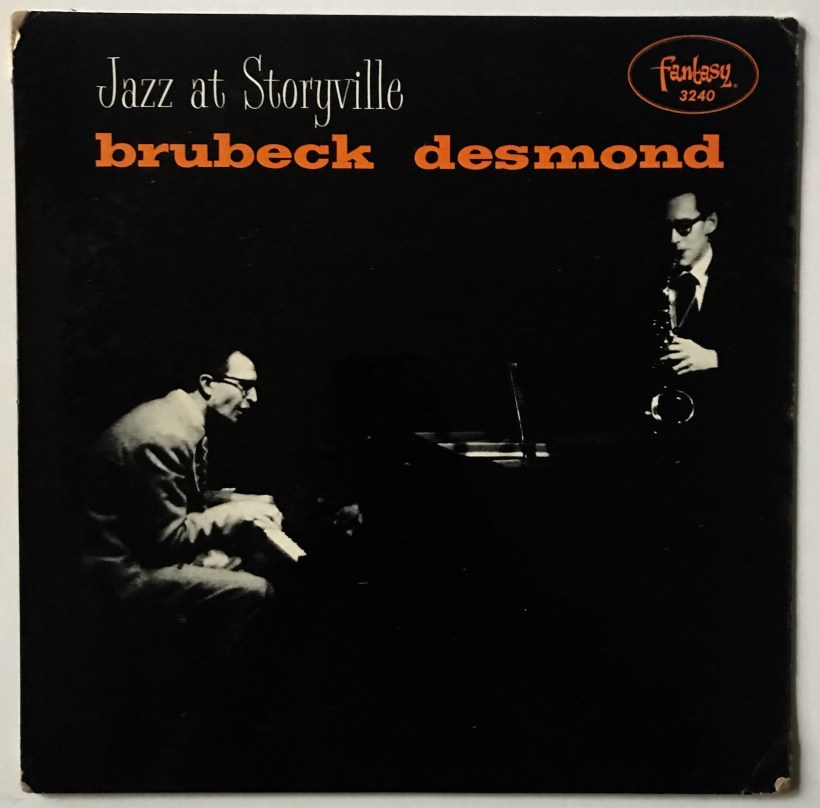 College Jazz Collector Rating: A
College Jazz Collector Rating: A
What an expressive photograph, one that perfectly captures the dark, moody vibe of a nightclub. It also embodies the spirit of jazz as a serious, slightly mysterious art form. The black and white photography, the shadows, the way Brubeck and Desmond seem to melt away in the darkness all contribute to the overall feeling of the eerie hipness that jazz is. The use of color in the type is eye-catching, causing one to first identify the musicians, then read the album title. Yeah, I like this album cover a lot. I wonder who took it…
The Back
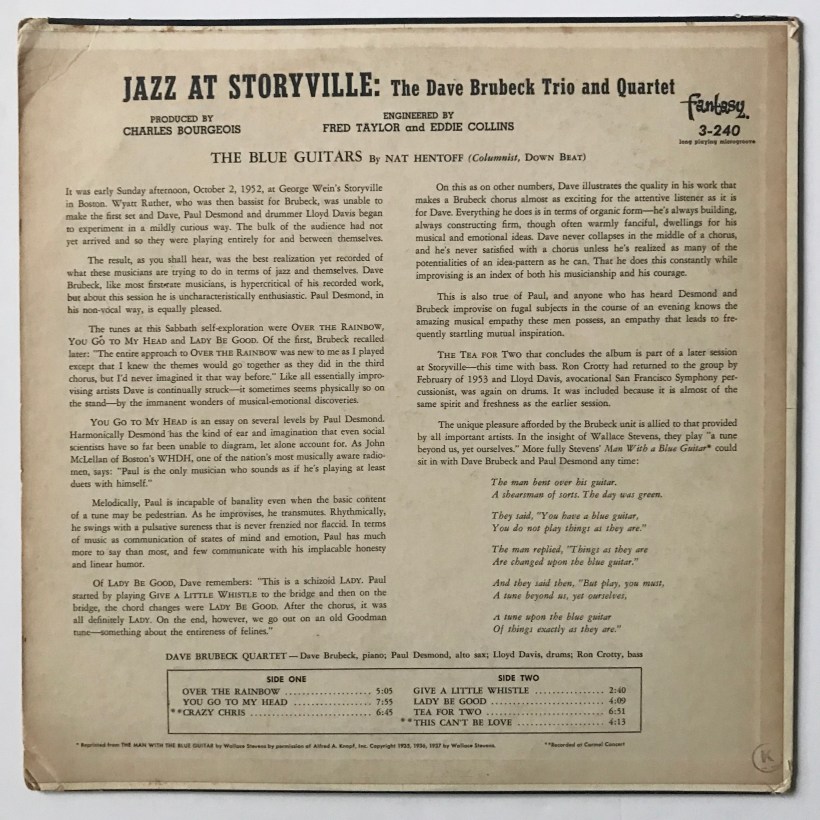 Naturally, in typical Fantasy fashion (say THAT ten times fast), there’s next to no info provided about the album, and the little that is provided is incomplete, or downright wrong. This album’s liner notes are simply the reproduced notes from the initial 10-inch album; as a result, there’s no information on the two tracks added on, other than their mention in the track listing. Who’s on bass? Who’s on drums? Who’s on first? You wouldn’t know if all you had was this album. And contrary to the asterisks, “This Can’t Be Love” was not recorded at that Carmel concert. And what about that stellar album cover art? Who took that picture? William Claxton? George Wein? Miles Davis? Me? We’ll never know. Come on, Fantasy.
Naturally, in typical Fantasy fashion (say THAT ten times fast), there’s next to no info provided about the album, and the little that is provided is incomplete, or downright wrong. This album’s liner notes are simply the reproduced notes from the initial 10-inch album; as a result, there’s no information on the two tracks added on, other than their mention in the track listing. Who’s on bass? Who’s on drums? Who’s on first? You wouldn’t know if all you had was this album. And contrary to the asterisks, “This Can’t Be Love” was not recorded at that Carmel concert. And what about that stellar album cover art? Who took that picture? William Claxton? George Wein? Miles Davis? Me? We’ll never know. Come on, Fantasy.
The liner notes themselves are pretty good, if not brief, written by Nat Hentoff. They feature mostly quotes from Mr. Brubeck and a poem. The quotes and notes are, for what they’re worth, insightful.
The Vinyl
As was Fantasy’s custom, this album was pressed on red translucent vinyl, deep-groove present and in mono. Something interesting I’ve noticed with the red Fantasy records is that the early Fantasy records are thicker, heavier, and a deeper red (oxblood-red?). The later pressings of mono Fantasy albums were on thinner, brighter red (fire engine-red?). The labels were also subtly different. The early Fantasy albums featured labels that were also deeper red and sometimes somewhat marbled or speckled. The later labels were brighter and uniformly red. Case en point:
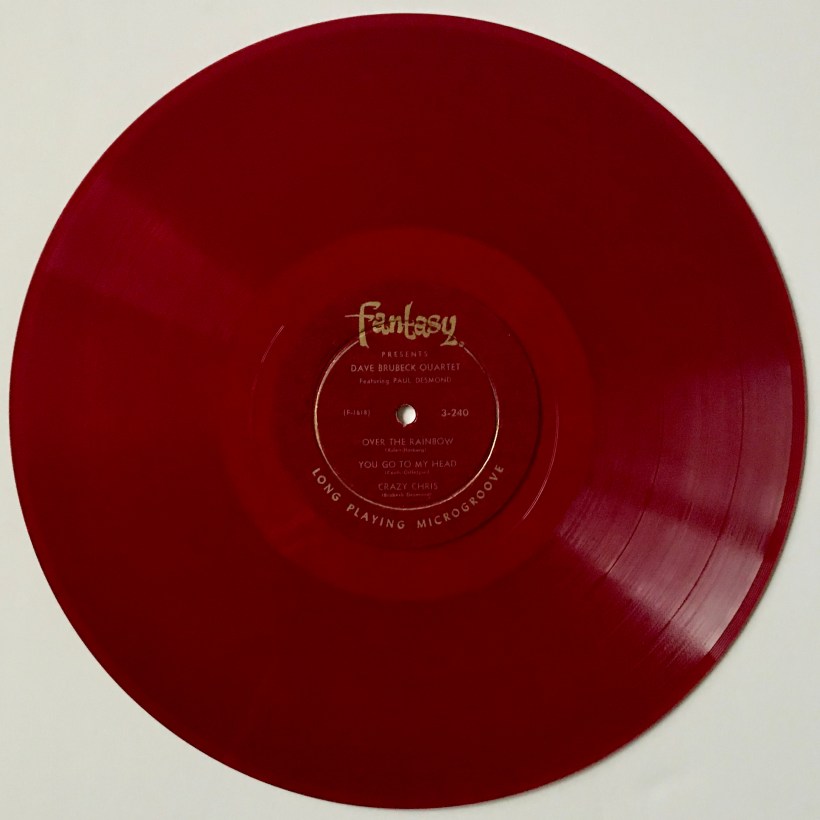 Fantasy 3240- Thick, deep groove, first edition record. Released in 1957
Fantasy 3240- Thick, deep groove, first edition record. Released in 1957
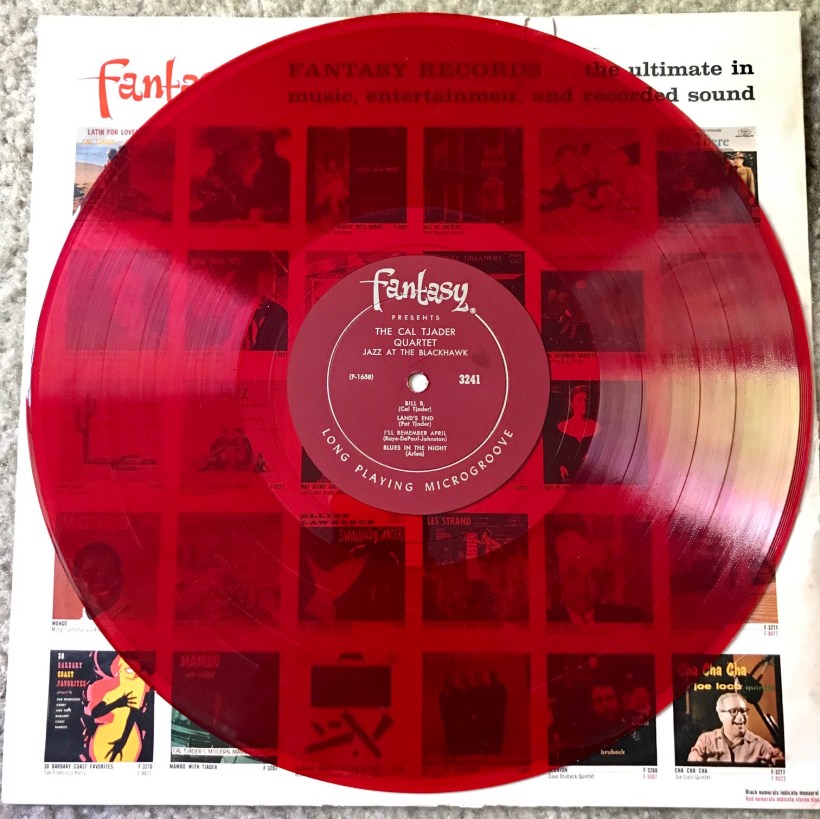 Fantasy 3241- Thinner, brighter minimally deep groove 2nd pressing from around 1959-60. Originally released in 1957.
Fantasy 3241- Thinner, brighter minimally deep groove 2nd pressing from around 1959-60. Originally released in 1957.
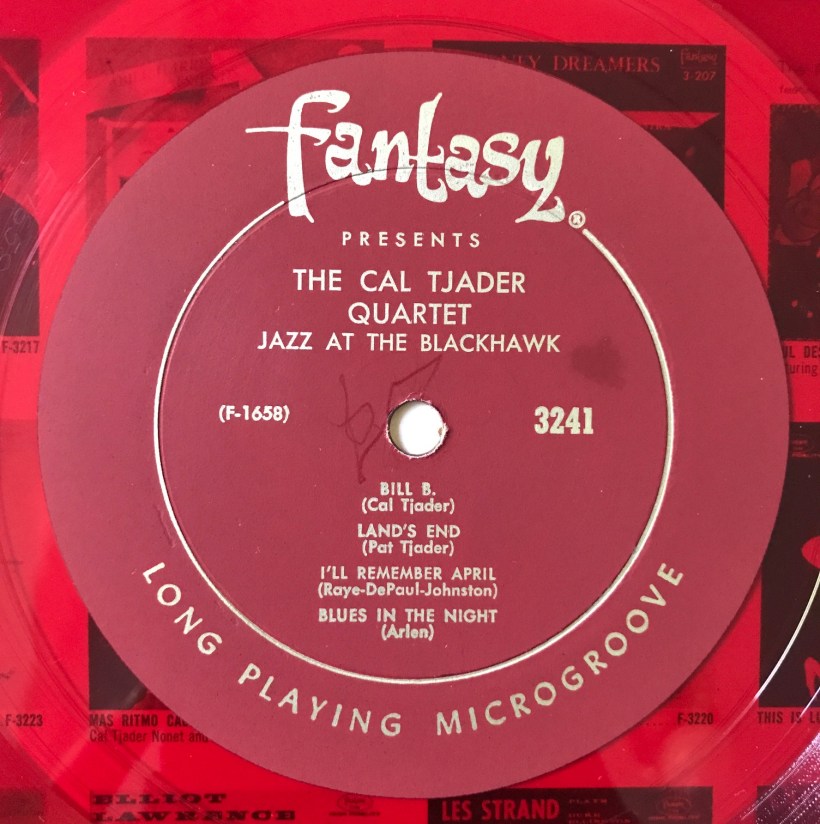 The change in color and label type seems to be around 1958, the time that Fantasy began to release records in stereo. I’m wondering if this had anything to do with the difference in color the of vinyl and labels? It’s probably something I’ll never know the answer to; it’s just one of those things that makes record collecting such an interesting hobby.
The change in color and label type seems to be around 1958, the time that Fantasy began to release records in stereo. I’m wondering if this had anything to do with the difference in color the of vinyl and labels? It’s probably something I’ll never know the answer to; it’s just one of those things that makes record collecting such an interesting hobby.
The Place of Acquisition
During one of my visits to the local record store, this record was peeking out at me from behind some other records in the new arrivals section. Sure, I had the album on my iPod, courtesy of iTunes, but why settle for the mp3 when you can get the original 60 year-old analog original, complete with liner notes? Plus, it was Paul Desmond’s personal favorite, so I HAD to grab it. It was a bit more expensive than most of my purchases at $20. “RED VINYL!” screamed the handwritten price tag, with “$20” directly below it. There’s a fierce debate among record collectors and audiophiles about whether colored vinyl is somehow inferior to the standard black vinyl. Some say that there’s definitely an audible difference between the colored vinyl and the black vinyl. Others say there’s not. As somebody who is both colored and black, I say that there’s nothing wrong with either. The only issue is if you refer to the different vinyl as “the coloreds” or “the blacks”. This is arguably worse than referring to them as “the vinyls”. You’ve been warned.



hi, swell
we exchanged emails a couple of years ago; i can’t remember the content because i lost stuff when my hard drive died
but i recall thanking you for resurrecting that wonderful album of brandenburg gate
i like all you say about the “storyville” album, but i must say my favorite on the album is “over the rainbow”, the way they hold the theme until the end, preceding it with almost quote-like hints, is exceptional
anyway, i enjoy your blog and your deep interest in brubeck
best, d
This was one of my first albums, I think, and I still have that red disc in my basement. My fav tracks are Over the Rainbow and You Go to My Head. There are other recordings of the latter with Brubeck and Desmond, but they are much more upbeat. I prefer this one, which is slower and feels much more introspective. While the album sadly does not appear to have been released on CD, I was thrilled tonight to find digital versions of my two favorite tracks. Your website came to my attention recently when an associate and I were researching something and he found your query about who the mysterious photographer might be who took the cover shot. Well, I was a longtime friend of that photographer, so we will answer your question in due time.
John Brook made the picture you like so much on the Live at Storyville album. Brook was a photographer in Boston. He lived a few blocks from Storyville, and he often photographed musicians — often for the Boston Symphony Orchestra. Here’s a link to our story about your blog post: http://johnbrookarchive.com/brubeck-album-cover.html
We linked the story back to your blogpost that inspired the story.
As further confirmation of the photographer for the cover image, you can see John Brook credited on the reverse of a slightly different cover design with the same image at https://m.blog.naver.com/antique4u/221863045604. See the notation in the upper righthand corner on the back of the album.
This was also one of my first albums, great music!
I have the Columbia release of this album. It lists “Oh, Lady Be Good” on it, but the song you get is “Give a Little Whistle”. This is just opposite of the Fantasy release. In my version, “Give a Little Whistle” gives way to a ka-jillion other songs, However, I never hear “Oh Lady”
Did the recording production crews screw up? Is Brubeck messing with us? Any ideas?
At https://www.amazon.com/dp/B01M0IGKOG/, they list the piece as “Give A Little Whistle/Oh, Lady Be Good (Medley – live at Storyville)” with a length of 6:51 minutes — so maybe different albums list this differently.
Hmmm… To further confuse things, I see that a different song is shown with a length of 6:51 on the back of the album cover on this post.
Give a